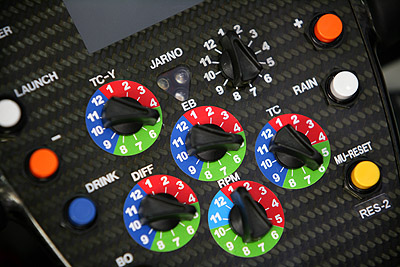


30/07/2007
NEWS STORY
 |
Formula 1 is a highly complex sport, where many elements of man and machine combine to strive for peak performance. But what is the story behind these details?
In the first part of Panasonic Toyota Racing's 'Formula 1 for Beginners' series, Chief Engineer Race and Test Dieter Gass explains the role of the steering wheel, brakes, driver's seat and tyres.
Even to the least technically-minded observer, the main role of the steering wheel is obvious – it is the outlet for a driver's split-second reactions, a high-tech paint brush for a Formula 1 artist. But there is much more to the steering wheel's function than simply changing direction.
Unlike a road car, which has a dashboard dotted with switches and levers, a Formula 1 car has only the steering wheel, so any option the driver needs to use while at the wheel must, literally, be at the touch of a button.
Dieter explains: "The steering wheel is a very important element of a car. Basically the steering wheel, apart from brake and throttle pedals, is everything the driver needs to control the car. Therefore on the front we have a lot of switches which the driver is using while he is driving, for example the pit speed limiter, or he can influence the traction control.
"But this is not everything because on the other side we have levers which the driver is operating to shift gears and as well the clutch because we don't have a foot-operated clutch pedal in the car."
With drivers using it to change gear up to 3,000 times a race, negotiate every turn of a 300km race, as well as change car settings, communicate with their team on the radio, and even operate their drinking system the steering wheel is a vital piece of equipment.
With all that high-speed action to deal with, a driver needs to be sitting comfortably, especially given the fearsome forces exerted on their bodies by the fastest racing cars in the world.
For that reason, Ralf Schumacher and Jarno Trulli have seats custom made to exactly fit the shape of their bodies, as Dieter explains: "The driver's seat is made onto the driver so it is the perfect shape in order to give him the best stability while he is driving. He has to be able to cope with an enormous amount of force when he is accelerating, braking or cornering."
Under such extremes, even the most minor discomfort is amplified and can become a real problem, affecting a driver's concentration and, ultimately, his wellbeing, so Panasonic Toyota Racing leaves nothing to chance and ensures a perfect fit for its drivers.
As well as comfort, safety is of critical importance and the driver's seat is enclosed in a carbon fibre monocoque – an extremely strong safety cell which protects the driver in case of an accident by absorbing an impact. Dieter adds: "It is very important to highlight to use of carbon fibre because this has increased the level of safety for the driver over the last 20 years so it is now very high."
With impressive acceleration and the ability to hit 160kmph in under six seconds, a Formula 1 car needs some serious stopping power, delivered by high-performance carbon brakes which, from that speed, can bring the car back to a stop in six seconds.
This is possible only by using carbon brakes, which have an operating temperature, on average, of 650°C and can get as hot as 900°C.
"The brakes are one of the elements which offer the biggest difference between a Formula 1 car and road car," Dieter says. "It starts with the material. We are using exclusively carbon brakes which offer very, very good performance in braking but carbon is a very sensitive material.
"The carbon brakes only work in the right temperature window - if you are below 300°C there is almost no braking at all so it is important to heat up the brakes. On the other hand it is important not to have the temperature too high. This is why we have big cooling ducts on all four brakes. In this way the temperature is controlled and we have the optimum brake temperature for the optimum braking performance."
Brakes are a crucial factor but, as with everything on a Formula 1 car, performance has to be transferred to the race track, and this is where tyres come in. As well as the two compounds of dry-weather tyres at each weekend, the softer of which is marked by a white line in one of the grooves, all teams also have wet and extreme wet tyres in case of rain.
All the energy produced by a Formula 1 car is transmitted to the track through a small contact patch on each of the four tyres, making grip levels and tyre wear rates critical to overall performance.
In 2007, Panasonic Toyota Racing is using Bridgestone Potenza tyres for the second successive season, but the overall situation changed from 2006, as Dieter explains: "This season is the first year since 2000 that everyone is using Bridgestone tyres exclusively and we have a total of four different compounds available over the season, two for every race weekend.
"The different compounds give different grip levels but what is similar is the working temperature. All the tyres work best on average at around 80°C, this is when they offer their best grip to the car. What we need to determine is what compound to use in which conditions, therefore we have four compounds available.
"If you have a surface with a very abrasive surface, for example Barcelona, it is difficult for the tyres so you would use a hard compound. On other circuits which are not so demanding, for example Monaco, you would use the softer compound."
As with everything In Formula 1, it is these details which combine to produce the ultimate performance.